Bulletin – June 2016 Global Economy Currency Risk at Emerging Market Firms
- Download the article 402KB
Abstract
Exchange rate fluctuations can affect the value of emerging market (EM) firms in several ways, including through trade-related and balance sheet channels. This article examines the effects of exchange rate fluctuations on listed EM firms' share prices. Overall, a depreciation of the exchange rate is estimated to lower the share prices of around 25 per cent of EM firms, while 15 per cent of firms benefit and the share prices of the remaining 60 per cent are unaffected by a lower exchange rate. Among firms with share prices that are sensitive to exchange rate fluctuations, those that are more indebted tend to be more adversely affected by depreciation. However, there is no significant association between the sensitivity of a firm's share price to exchange rate fluctuations and the size of that firm's foreign currency-denominated debts, consistent with the prevalence of natural hedging among EM firms with such debt.
Introduction
There has been a substantial increase in the value of EM firms' foreign currency-denominated debt over recent years, although growth in such debt has been modest when measured as a share of GDP (Graph 1).[1] The rise in foreign currency-denominated debt has been accompanied by even stronger growth in local currency-denominated debt, such that total debt as a per cent of GDP has risen notably.
Past EM crises have led to a large body of work examining the drivers of increases in EM firms' debt and the attendant risks, including risks associated with exchange rate depreciation (Kofanova, Walker and Hatzvi 2015).[2], [3] This article focuses on the exposure of EM firms to currency risk; in particular, how firms' share prices are affected by exchange rate fluctuations.
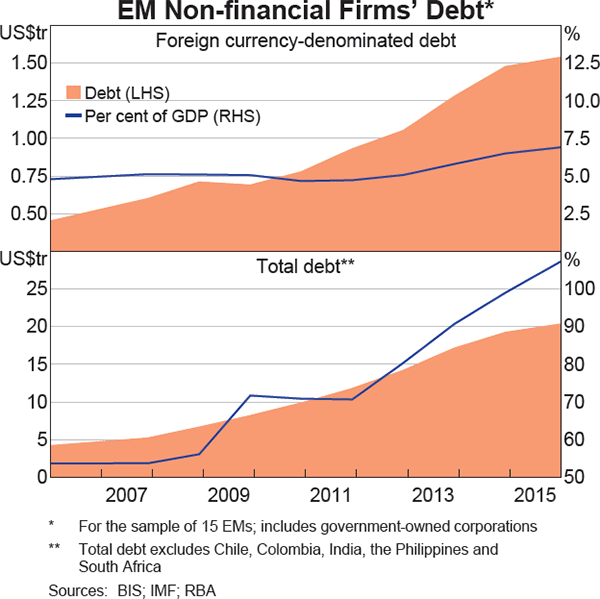
From an aggregate perspective, these firms' exposure to currency risk (to the extent that such risks affect share prices) could be one factor behind the 20 per cent fall in EM equity prices since mid 2014, which has occurred alongside a depreciation of EM exchange rates (Graph 2). However, the correlation between equity prices and exchange rates might also reflect other factors, such as slowing economic growth in EMs, falling commodity prices and broad-based portfolio outflows, including those related to expectations of rising interest rates in the United States. Identifying the effect of exchange rate movements on firms' share prices therefore requires more careful empirical analysis.
Exchange rate fluctuations affect a firm's value (and therefore its share price) through different channels. All else equal, net importers (of either final goods or inputs into production) would be expected to benefit from a higher exchange rate (which makes imports cheaper), but exporters or import-competing firms would benefit from a lower exchange rate. However, these trade-related channels could be overlaid with possibly offsetting or exacerbating foreign currency-denominated positions: firms with net foreign currency-denominated debt positions will benefit from a higher exchange rate (all else equal), while those with net foreign currency-denominated assets will benefit from a lower exchange rate.[4]
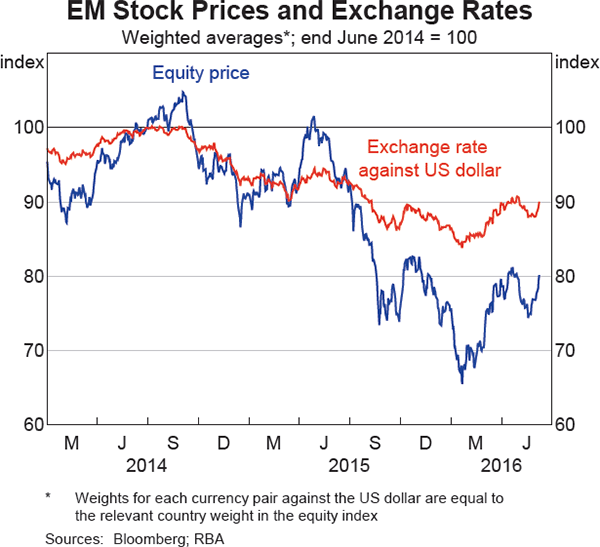
This article estimates the balance of these effects on individual firms' share prices by estimating exchange rate sensitivities for a large sample of listed non-financial firms within 15 EMs over the period 2000–15. For firms with share prices that are found to be sensitive to exchange rate fluctuations, the association between exchange rate sensitivities and debt is then examined.
Exchange Rate Sensitivities of EM Firms' Share Prices
In this article, exchange rate sensitivities of individual EM firms are estimated by looking at the impact of a change in the exchange rate on a firm's share price, after controlling for the return on the relevant national stock index.
This particular approach to estimating exchange rate sensitivities has two important features. First, because market information is used, these estimated sensitivities should take into account natural hedges (for example, if the firm earns foreign currency-denominated revenues) and financial hedges (for example, if the firm holds financial instruments like derivatives) to the extent that these hedges are visible to investors (Bodnar and Bartram 2007). This is a useful feature of the firm-level data, as such hedges are ‘notoriously hard to assess’ at EM firms from an aggregate policymaker's perspective (Chui et al 2014). Second, controlling for the stock market index captures the confounding effects of other economy-wide factors that affect both firm values and the value of the local currency.[5] For example, a reduction in interest rates could simultaneously increase share prices (by stimulating economic activity) and lower the exchange rate, but the co-movement between share prices and the exchange rate would not imply that a firm's share price is directly affected by the exchange rate itself.
One concern with using the stock market index as a control, however, is that the resulting estimates only capture a firm's exchange rate sensitivity over and above the exchange rate sensitivity of its respective market, and not how a firm is affected by exchange rate fluctuations in an overall sense. In particular, if the market itself is directly affected by exchange rate fluctuations, then an estimated sensitivity of zero (relative to that market) does not mean the firm is unaffected by exchange rate movements.
One way to obtain an estimate of a firm's exchange rate sensitivity that can be interpreted more closely as an overall sensitivity is to control for a measure of the stock market's return that is unaffected by fluctuations in the exchange rate. In particular, ‘adjusted market returns’ are estimated as the residual from country-level regressions of local stock market returns on the change in the nominal trade-weighted index (TWI) (Kiymaz 2003). This ‘adjusted market return’ is independent of the direct impact of exchange rate fluctuations, but still controls for other economy-wide factors.
Specifically, the following equation is estimated separately for each firm i (that is, for each of the 6,300 firms in the data set) at a monthly frequency over the period 2000–15 to obtain the exchange rate sensitivity of the firm's share price:
Returnit is firm i's stock return over month
t,  is the relevant ‘adjusted market return’
and ΔTWIt is the percentage change in the relevant
nominal trade-weighted exchange rate. The coefficient of interest, Ei,
captures a firm's overall exchange rate sensitivity, or elasticity, such
that:
is the relevant ‘adjusted market return’
and ΔTWIt is the percentage change in the relevant
nominal trade-weighted exchange rate. The coefficient of interest, Ei,
captures a firm's overall exchange rate sensitivity, or elasticity, such
that:
- a firm has a positive sensitivity if Ei is positive – in this case, the firm's share price increases in response to an appreciation of the exchange rate, or declines in response to a depreciation; and
- a firm has a negative sensitivity if Ei is negative – in this case, the firm's share price decreases in response to an appreciation.
The use of the TWI in Equation (1) provides the broadest estimate of exchange rate sensitivities by capturing changes in firms' competitiveness and profitability induced by movements in the exchange rates of a country's trading partners. However, many EM firms may be primarily exposed to the US dollar through channels other than trade-related competitiveness, in particular US dollar-denominated borrowings and trade settlements. For example, about 90 per cent of Chinese firms' foreign currency-denominated borrowings are US dollar denominated. For this reason, Equation (1) is also estimated using bilateral exchange rates against the US dollar.
The sample spans 15 EMs and comprises all listed non-financial firms for which sufficient data were available to estimate Equation (1). After removing outliers, there are around 6,300 firms (Table A1).[6], [7] Each EM is represented in the sample broadly according to its actual relative market capitalisation, with the exception of a significant underweighting of Chinese firms. This reflects the fact that financial firms, which are excluded from the sample, have a large weight in China's main share market index. Nevertheless, Chinese firms still make up nearly one-third of the sample.
The results provide an estimate of a firm's exchange rate sensitivity (that is, the percentage change in its share price that is associated with a 1 per cent change in the relevant TWI). For ease of presentation, the results for all firms are plotted as a distribution (Graph 3).
Across all firms there is a clear distribution in exchange rate sensitivities, which is roughly symmetric around the median firm's sensitivity, which is close to zero.[8] Some firms display large positive sensitivities, while others display large negative sensitivities: for one-quarter of firms, a 1 per cent depreciation of the TWI is associated with a decline in market value of 1 per cent or more (exhibit positive sensitivity), while for almost the same share of firms, it is associated with an increase in market value of 1 per cent or more (exhibit negative sensitivity).
For a little under 40 per cent of firms, the sensitivity of the share price to exchange rate fluctuations is statistically significant (at the 10 per cent level). Looking just at these firms, there is an asymmetric distribution, such that almost two-thirds of firms have positive sensitivities (that is, these firms' share prices are negatively affected by an exchange rate depreciation).[9] Accordingly, among firms with statistically significant sensitivities, the median sensitivity shows that a 1 per cent depreciation of the TWI is associated with a decline in market value of almost 1 per cent (Table 1). To put these figures into an aggregate context, taking the share of significantly sensitive firms (37 per cent) and multiplying it by the median sensitivity (0.9 per cent) implies that a 1 per cent fall in the aggregate EM TWI would directly lower the aggregate EM share price index by around one-third of 1 per cent (ignoring differences in firm size).
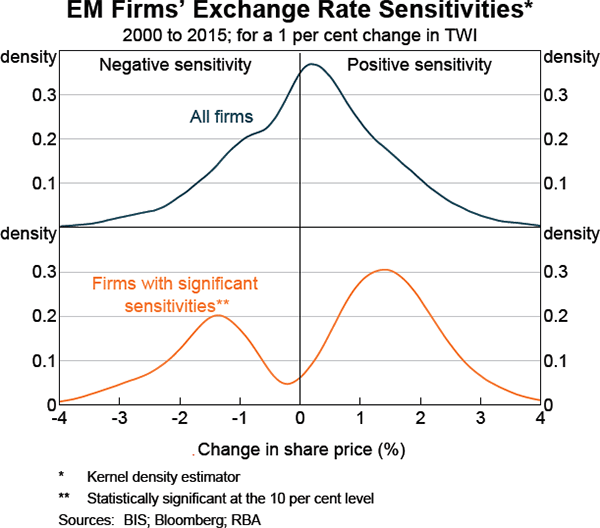
If the relevant exchange rate is the US dollar exchange rate rather than the TWI, a larger share of firms is estimated to be statistically sensitive to exchange rate fluctuations, at around 45 per cent. There is also a larger asymmetry in the distribution towards firms with a positive sensitivity, that is, firms with a stock price that falls as a result of a depreciation (Graph B1). The estimated median sensitivity among significantly sensitive firms in this case is therefore a little larger, with a 1 per cent depreciation of the bilateral exchange rate against the US dollar associated with a 1.2 per cent decline in market value. Multiplying this estimated sensitivity by the share of significantly exposed firms implies that a 1 per cent fall in the aggregate EM exchange rate index against the US dollar would directly lower an equivalent aggregate EM share price index by around one-half of one per cent.
| All countries | China | |||
|---|---|---|---|---|
| TWI | Against USD | TWI | Against USD | |
| All firms | ||||
| Median sensitivity | 0.2 | 0.6 | −1.6 | −0.1 |
| Firms with significant sensitivity | ||||
| Share of all firms (%) | 37 | 46 | 41 | 11 |
| Median sensitivity | 0.9 | 1.2 | −1.6 | −2.4 |
| Firms with significant positive sensitivity | ||||
| Share of all firms (%) | 23 | 43 | 0 | 4 |
| Median sensitivity | 1.5 | 1.2 | na | 3.7 |
| Firms with significant negative sensitivity | ||||
| Share of all firms (%) | 14 | 3 | 41 | 7 |
| Median sensitivity | −1.5 | −2.7 | −1.6 | −3.1 |
| Number of firms | 6,287 | 1,792 | ||
|
(a) Per cent change in a firm's share price associated with a 1 per cent change in the nominal exchange rate; significance calculated at the 10 per cent level using heteroskedasticity- and autocorrelation-consistent (HAC) standard errors Sources: BIS; Bloomberg; RBA |
||||
Chinese firms are a notable exception to these results. While around 40 per cent of firms are estimated to have statistically significant sensitivities on a TWI basis (similar to the overall results above), almost all of these firms have negative sensitivities and so these firms' share prices increase with exchange rate depreciation. In fact, Chinese firms account for around 85 per cent of all negative and significant sensitivities (on a TWI basis) in the overall sample. The share of Chinese firms with significant sensitivities to the US dollar bilateral exchange rate is much smaller. In part, this result is likely to reflect the lack of variation in the US dollar bilateral exchange rate over the sample period, which makes it difficult to identify statistically significant exchange rate sensitivities. However, it could also reflect the fact that most Chinese firms are net exporters with little US dollar-denominated debt relative to assets. Hence, they are generally more affected by trade-related competitiveness channels (which operate through a basket of trading-partner exchange rates captured by the TWI) rather than balance sheet channels (which tend to operate through the bilateral US dollar exchange rate).
Country- and industry-level sensitivities
It is also possible to analyse the patterns of median exchange rate sensitivities across countries and across industries, where the median is calculated from the set of firms with statistically significant exposures (Graph 4 and Graph 5). By country, there appears to be some positive relationship between exchange rate sensitivities and the aggregate level of US dollar-denominated non-financial corporate debt outstanding (as a share of GDP). This is the case regardless of whether median exchange rate sensitivities by country are calculated using only firms with statistically significant sensitivities or using all firms. For example, the median exchange rate sensitivity is highest (and positive) in the Philippines, where the ratio of US dollar-denominated non-financial corporate sector debt to GDP is relatively high among the sample of EMs, whereas the median exchange rate sensitivity is negative in Argentina, where the ratio of US dollar-denominated debt to GDP is relatively small. However, the relationship between the aggregate level of US dollar-denominated non-financial corporate debt outstanding (as a share of GDP) and the magnitude of exchange rate sensitivities across all countries is not very strong, with a weak positive correlation of 0.1. Hedging could be one explanation for why the relationship between these two variables is not stronger, consistent with the role of hedging found in previous results in the literature (Dominguez and Tesar 2006).
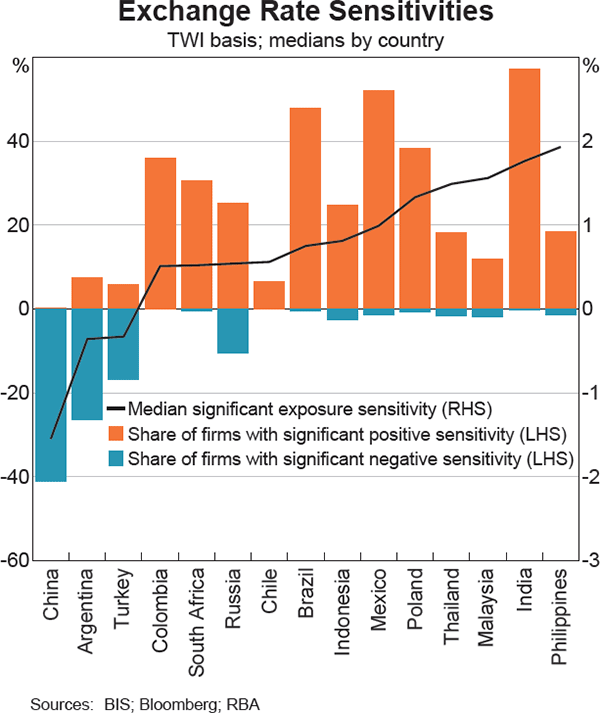
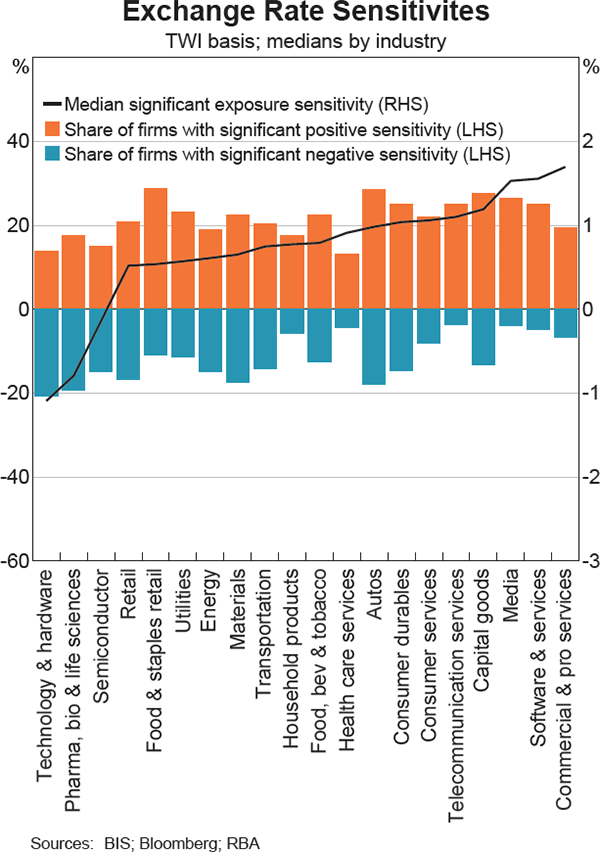
Likewise, by industry, there are patterns that are consistent with likely trade sensitivities, but these do not appear to be strong. For example, the technology & hardware, pharmaceuticals, biotechnology & life sciences and semiconductor industries have median negative sensitivities, indicating that they tend to benefit from currency depreciation. To the extent that these are net exporting industries, this is consistent with a pattern of sensitivities due to trade channels.[10] On the other hand, service sector industries – such as commercial & professional services, software & services, media and telecommunication services – have positive exchange rate sensitivities, possibly due to these industries' reliance on imported inputs.
Exchange Rate Sensitivities and Debt
EM firms with unhedged foreign currency-denominated debt could be expected to be more adversely affected by exchange rate depreciation relative to other firms. This section examines this potential relationship by looking at the association between exchange rate sensitivities and debt (both local and foreign currency) for those firms that have been identified as being significantly sensitive to exchange rate fluctuations. Results were also considered using the full sample of firms – with significant sensitivities or otherwise – where estimation uncertainty in the exchange rate sensitivities, Ei, was accounted for using weighted least squares. The results were consistent with those presented below, based on pooled ordinary least squares (OLS).
Importantly, the estimated relationship between exchange rate sensitivities and debt controls for country-specific characteristics, which capture factors such as a country's openness to international trade and the hedging opportunities available within its financial infrastructure. The estimated relationship also controls for firm-specific characteristics, including each firm's size and the liquidity of its assets. These firm-specific factors capture the idea that larger firms may be better placed to employ financial hedges that limit sensitivities, while more liquid firms may have partial buffers against currency risks (see Appendix C for details of the regression).
There is an estimated positive correlation between the extent of exchange rate sensitivity and total debt, implying that the share prices of companies with larger debts are more likely to benefit from a currency appreciation than depreciation (Table 2; columns 1 and 3). In terms of economic significance, an increase in the average firm's debt-to-assets ratio of 30 percentage points (equivalent to an increase in the ratio from the 25th percentile to the 75th percentile) would leave the firm's share price 10–15 basis points more sensitive to a 1 per cent change in the exchange rate.
One possible explanation for this result is that it is driven by the exchange rate effect on foreign currency-denominated debt. However, decomposing the debt-to-assets ratio into its local currency-denominated component (LCY debt) and its foreign currency-denominated component (FX debt; columns 2 and 4) indicates that the association between total debt and exchange rate sensitivities is not driven by the foreign currency-denominated component of debt (consistent with Acharya et al (2015) for Indian firms).[11] This result holds when considering foreign currency-denominated debt as a share of total assets in Equation (C2), as well as when foreign currency-denominated debt is expressed as a share of total debt. These results are consistent with the finding that exchange rate sensitivities arising from foreign currency-denominated debt tend to be held by those with some degree of natural hedging (Kofanova et al 2015).
| TWI basis | Against the US dollar | |||
|---|---|---|---|---|
| Total debt regression | Debt decomposition regression | Total debt regression | Debt decomposition regression | |
| Debt | 0.45*** | 0.30** | ||
| LCY debt(b) | 0.51** | 0.52*** | ||
| FX debt(b) | −0.38 | −0.15 | ||
| Size | −0.02 | 0.00 | −0.04** | 0.05*** |
| Liquidity | −0.26 | −0.76* | −0.12 | −0.62** |
| Adjusted R2 | 0.42 | 0.32 | 0.36 | 0.43 |
| Observations | 1,684 | 588 | 1,684 | 588 |
|
(a) ***, ** and * indicate significance at the 1, 5 and 10 per cent level,
respectively; HAC standard errors; outliers excluded; coefficients on
the country dummies are omitted Sources: BIS; Bloomberg; RBA |
||||
An alternative explanation for the finding that total outstanding debt, but not foreign currency-denominated debt, is associated with exchange rate sensitivities is that total debt may be a proxy for the riskiness of the firm more generally, rather than directly capturing the extent of balance sheet exposure to exchange rate fluctuations. For instance, an exchange rate depreciation could cause local financial conditions to tighten, as the monetary authority increases interest rates to avoid higher inflation, thereby putting downward pressure on the stock prices of more indebted firms. In addition, investors may not have timely visibility over EM firms' foreign currency-denominated debts and so indiscriminately sell down highly indebted firms' stocks following an exchange rate depreciation, regardless of the currency composition of firms' debts.
Looking at the estimates on the control variables, there is also some evidence to suggest that smaller firms and those with less liquid assets have larger exchange rate sensitivities, consistent with the idea that larger firms may have better access to financial hedging opportunities, while less liquid firms may have smaller buffers to deal with potential vulnerabilities (Dominguez and Tesar 2006).
Conclusion
There are a number of different channels through which exchange rate fluctuations can positively or negatively affect the value of EM firms. For the large sample of firms covered in this article, around 40 per cent of EM firms' share prices are estimated to be statistically sensitive to exchange rate movements, with an exchange rate depreciation lowering the value of almost two-thirds of these firms. However, among the firms with share prices that are sensitive to exchange rate changes, there is no association between the sensitivity of these firms' share prices to movements in the exchange rate and the size of these firms' foreign currency-denominated debt. Nevertheless, there is a positive association between a firm's exchange rate sensitivity and that firm's total debt, which may occur through other channels, such as the connection between exchange rate depreciation and a deterioration in risk sentiment, or the connection between depreciation and a prospective tightening in monetary policy.
Appendix A
The Sample
| Country | Number of firms(a) | Share of all firms | Actual market capitalisation | Share of market capitalisation |
|---|---|---|---|---|
| (%) | US$b – end 2015(b) | % – end 2015(b) | ||
| China | 1,792 | 29 | 8,188 | 60 |
| India | 1,250 | 20 | 1,516 | 11 |
| Malaysia | 707 | 11 | 383 | 3 |
| Poland | 464 | 7 | 138 | 1 |
| Thailand | 445 | 7 | 349 | 3 |
| Indonesia | 355 | 6 | 353 | 3 |
| Turkey | 287 | 5 | 189 | 1 |
| Brazil | 213 | 3 | 491 | 4 |
| South Africa | 196 | 3 | 736 | 5 |
| Russia | 171 | 3 | 393 | 3 |
| Philippines | 135 | 2 | 239 | 2 |
| Chile | 123 | 2 | 190 | 1 |
| Mexico | 71 | 1 | 402 | 3 |
| Argentina | 53 | 1 | 56 | 0 |
| Colombia | 25 | 0 | 86 | 1 |
| Total | 6,287 | 100 | 13,709 | 100 |
|
(a) Outliers excluded by trimming the top and bottom 1 per cent of the
distribution of the relevant variables in order to control for the
effect of implausible values Sources: Bloomberg; RBA; World Bank |
||||
Appendix B
Additional Results
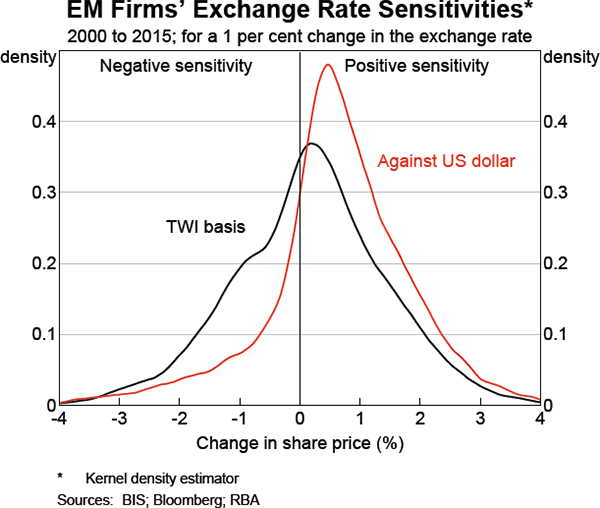
Appendix C
Exchange Rate Sensitivities and Debt
This appendix details the regression used to estimate the association between firm-level exchange rate sensitivities and debt.
For each firm i of country c the following pooled cross-sectional regression was estimated, with all the right-hand side variables measured as of end 2014 when firm-level data on the balance sheet items are the most comprehensive: [12]
Here, Ei denotes the exchange rate sensitivities from Equation (1) that are estimated over the period 2000–15. The coefficient of most interest, ⌈, captures the association between a firm's debt-to-assets ratio, debti, and its exchange rate sensitivity. Country-specific factors are captured by dummy variables for each country, Ac, with In(sizei) denoting the log of each firm's total assets and liquidityi denoting each firm's ratio of cash and near-cash securities to total assets.
For the purposes of a separate regression given by Equation (C2) below, the debt-to-assets ratio was then decomposed into its foreign currency-denominated component, FX debti, and its local currency-denominated component, LCY debti. The interest here is on the coefficient γ1 in Equation (C2), which captures the association between sensitivities and foreign currency-denominated debt.
Looking at Table 2, the model using total debt can account for around 40 per cent of the variation in exchange rate sensitivities on a TWI basis. Much of that explanatory power comes from the country-specific controls used in Equation (C1). But, even after abstracting from these, over 10 per cent of the variation in the estimated exchange rate sensitivities is accounted for by movements in the balance sheet variables alone.
Footnotes
The author is from International Department. [*]
In this article, the term ‘emerging market (EM)’ refers to the following 15 markets: Argentina, Brazil, Chile, China, Colombia, India, Indonesia, Malaysia, Mexico, the Philippines, Poland, Russia, South Africa, Thailand and Turkey. [1]
Risks other than currency risks associated with the increase in EM firms' debt include: cash-flow risk (which is especially relevant for commodity producers, where recent falls in commodity prices reduce revenue, thereby increasing the likelihood of shortfalls in cash flow that leave them unable to meet interest payments); maturity-mismatch risks; rollover risks; and speculative risks (which can arise when EM firms exploit carry trade opportunities across domestic and foreign debt markets; Avdjiev, Chui and Shin (2014)). [2]
The International Monetary Fund dedicated a significant part of its October Global Financial Stability Report to analysing the increase in debt among EM firms, its causes and implications (IMF 2015). The Bank for International Settlements has also been actively highlighting risks associated with rising debt at EM firms (Chui, Fender and Sushko 2014; McCauley, McGuire and Sushko 2015; Caruana 2016), as has the Brookings Institute and others (Acharya et al 2015; Obrtacova and Barrett 2013; Milne 2014). [3]
The determinants of exchange rate sensitivities are more complex than this stylised description. For example, exchange rate fluctuations could simultaneously affect a firm's balance sheet, cash flows and competitiveness, and also lead to significant changes in firms' behaviour. Firms could also react to sensitivities by shifting production from one location to another. For a discussion of these interrelationships, see Bartram, Brown and Minton (2010). [4]
The change in the US dollar-denominated commodity price index was also considered as a control, but this did not materially affect the results presented below. [5]
Most firms in the sample are present for the full 16 years, suggesting that the results could potentially be affected by survivorship bias. This notwithstanding, all of the results are qualitatively similar if the sample is split into firms that have been present for 8 years or less, versus those that have been present for at least 9 years. [6]
To control for the possible effect of implausible values, the top and bottom 1 per cent of sensitivities are trimmed as well as the top and bottom 1 per cent of the balance sheet variables used later in the article (total assets, liquid assets and debt). To further abstract from the effect of outliers, medians are used to describe the resulting exchange rate sensitivity estimates. [7]
These results do not change if only ‘large’ exchange rate fluctuations are considered, defined as exchange rate movements above the 75th percentile for a given country. [8]
Using the raw market return index (rather than the adjusted market return index) as a control in Equation (1) produces a lower share of firms with significant sensitivities, as expected, with around 20 per cent of firms significantly affected by exchange rate fluctuations at the 10 per cent level of significance. [9]
It is also possible, however, that these industries, which typically operate cross-country production networks (Berger-Thomson and Doyle 2013), exhibit very little sensitivity to the exchange rate because they are able to adjust operational structures geographically to adapt to exchange rate changes. [10]
Decomposing total debt into its currency components does, however, limit the sample of firms with available data to those that are from Brazil, India, Indonesia, Mexico and the Philippines. [11]
If a firm is aware of its exchange rate sensitivity, and adjusts its debts accordingly, then this raises the possibility that the association in Equation (C1) runs from exchange rate sensitivities to debt. To address this possibility of reverse causation, Equation (C1) was re-estimated using exchange rate sensitivities that were estimated over the period 2007–15 and instrumenting debti measured in 2014 with its level at the end of 2006. The results are similar to those presented in Table 2. However, this robustness check cannot be performed for foreign currency-denominated debt due to data limitations. [12]
References
Acharya V, SG Cecchetti, J De Gregorio, Ş Kalemli-Özcan, PR Lane and U Panizza (2015), Corporate Debt in Emerging Economies: A Threat to Financial Stability?, Report by the Committee on International Economic Policy and Reform, Brookings Institution and Centre for International Governance Innovation, Washington DC.
Avdjiev S, M Chui and HS Shin (2014), ‘Non-Financial Corporations from Emerging Market Economies and Capital Flows’, BIS Quarterly Review, December, pp 67–77.
Bartram S, G Brown and B Minton (2010), ‘Resolving the Exposure Puzzle: The Many Facets of Exchange Rate Exposure’, Journal of Financial Economics, 95(2), pp 148–173.
Berger-Thomson L and M-A Doyle (2013), ‘Shifts in Production in East Asia’, RBA Bulletin, June, pp 29–37.
Bodnar G and S Bartram (2007), ‘The Exchange Rate Exposure Puzzle’, Managerial Finance, 33(9), pp 642–666.
Caruana J (2016), ‘Credit, Commodities and Currencies’, Lecture at the London School of Economics and Political Science, London, 5 February.
Chui M, I Fender and V Sushko (2014), ‘Risks Related to EME Corporate Balance Sheets: The Role of Leverage and Currency Mismatch’, BIS Quarterly Review, September, pp 35–47.
Dominguez K and L Tesar (2006), ‘Exchange Rate Exposure’, Journal of International Economics, 68(1), pp 188–218.
IMF (International Monetary Fund) (2015), Global Financial Stability Report: Vulnerabilities, Legacies, and Policy Challenges: Risks Rotating to Emerging Markets, October, World Economic and Financial Surveys, IMF, Washington DC.
Kiymaz H (2003), ‘Estimation of Foreign Exchange Exposure: An Emerging Market Application’, Journal of Multinational Financial Management, 13(1), pp 71–84.
Kofanova S, A Walker and E Hatzvi (2015), ‘US Dollar Debt of Emerging Market Firms’, RBA Bulletin, December, pp 49–57.
McCauley R, P McGuire and V Sushko (2015), ‘Dollar Credit to Emerging Market Economies’, BIS Quarterly Review, December, pp 27–41.
Milne A (2014), ‘Facts, Fiction and FX Vulnerabilities’, Bank of America Merrill Lynch Global Emerging Markets Credit Research', 25 February.
Obrtacova K and V Barrett (2013), ‘EM Corporates: Rising Leverage, Rising Risk’, Morgan Stanley EM Profile, 18 November.


